Butcher block countertops bring a warm, rustic charm to any kitchen. They are aesthetically pleasing but also functional and durable when properly maintained. This guide will walk you through everything you need to know about caring for your butcher block countertops, ensuring they remain beautiful and long-lasting.
Understanding Butcher Block Countertops
Composition and Types
Butcher block countertops are crafted from wooden boards that are glued together. The wood used can vary, with popular choices including maple, oak, cherry, walnut, and teak. Each wood type brings its unique color and grain pattern, adding character to your kitchen. The construction of butcher block countertops can be categorized into three types: edge grain, end grain, and face grain. Edge grain is made from long, narrow boards glued with their edges forming the surface, creating a striped appearance. End grain, often used for cutting boards, showcases the ends of the wood pieces, resulting in a checkerboard pattern. Face grain features the wide, flat surfaces of the boards, displaying the wood’s natural patterns prominently.
Advantages of Butcher Block Countertops
One of the main advantages of butcher block countertops is their natural beauty. The warmth and texture of wood add an inviting element to any kitchen decor. Additionally, butcher block is highly versatile and can complement both traditional and modern styles. These countertops are also relatively gentle on knives compared to other surfaces like stone or metal, making them a preferred choice for avid cooks. Moreover, with proper care, butcher block countertops can last for decades, making them a cost-effective investment.
Drawbacks to Consider
While butcher block countertops have numerous benefits, they also come with a few drawbacks. Wood is susceptible to scratches, dents, and stains if not properly maintained. Regular sealing and oiling are necessary to protect the surface from moisture and bacterial growth. Additionally, butcher blocks is sensitive to temperature changes and can warp or crack if exposed to excessive heat or humidity. It also requires more maintenance compared to non-porous materials like quartz or stainless steel.
Choosing the Right Butcher Block
When selecting a butcher block countertop, consider the type of wood and the construction method that best suits your needs and aesthetic preferences. Hardwoods like maple and oak are more durable and resistant to scratches, making them ideal for high-traffic kitchens. If you prefer a more decorative look, cherry and walnut offer rich colors and beautiful grain patterns. End grain butcher blocks are highly durable and can withstand heavy chopping, while edge grain and face grain are better suited for light to moderate use. Additionally, ensure the butcher block is properly treated with food-safe finishes to enhance its longevity and safety.

Maintenance and Cleaning
Daily Cleaning Routine
Maintaining the cleanliness of your butcher block countertop is essential for its longevity and hygiene. Begin by wiping down the surface with a damp cloth to remove any food particles or spills. For deeper cleaning, use a mild dish soap diluted in warm water and a soft sponge. Avoid using harsh chemicals or abrasive cleaners, as they can damage the wood. After cleaning, dry the countertop thoroughly with a clean towel to prevent water from seeping into the wood and causing damage.
Dealing with Stains and Odors
Despite your best efforts, stains and odors can occasionally occur on butcher block countertops. For light stains, a mixture of baking soda and water can be effective. Apply the paste to the stained area, let it sit for a few minutes, and then scrub gently with a soft sponge. For tougher stains, a lemon and salt combination can work wonders. Cut a lemon in half, sprinkle salt on the stained area, and use the lemon to scrub the stain in a circular motion. To eliminate odors, sprinkle baking soda over the surface, let it sit for a few hours, and then wipe it off with a damp cloth.
Regular Oiling and Sealing
One of the most important aspects of caring for a butcher block countertop is regular oiling and sealing. This process helps to protect the wood from moisture, stains, and bacterial growth. Food-grade mineral oil is commonly used for this purpose. Begin by ensuring the countertop is clean and dry. Apply a generous amount of oil to the surface using a clean cloth or a brush, working in the direction of the grain. Allow the oil to soak in for at least a few hours or overnight, then wipe off any excess with a dry cloth. For added protection, you can also use a butcher block conditioner or a mixture of beeswax and mineral oil.
Sanding and Refinishing
Over time, butcher block countertops may develop scratches, dents, or other signs of wear. Sanding and refinishing can restore their original beauty and smoothness. Start by thoroughly cleaning the surface and removing any existing finish. Use fine-grit sandpaper to sand the countertop in the direction of the grain, gradually working up to a higher grit for a smoother finish. After sanding, wipe away the dust with a damp cloth and allow the wood to dry. Finally, apply a fresh coat of oil or sealer to protect the surface and enhance its appearance. This process can be done as needed, depending on the condition of your countertop.
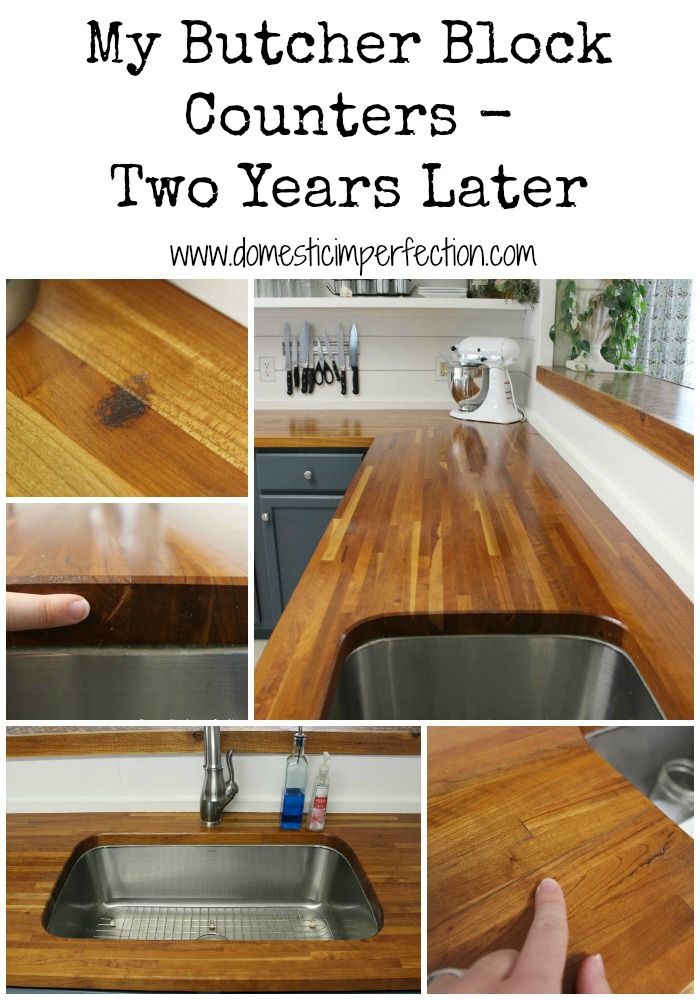
Preventive Measures
Protecting from Heat and Moisture
To prolong the life of your butcher block countertop, it’s crucial to protect it from excessive heat and moisture. Always use trivets or hot pads under hot pots and pans to prevent heat damage. Avoid placing wet items directly on the wood, as prolonged exposure to moisture can cause warping and cracking. Additionally, wipe up spills immediately to prevent water from penetrating the wood. In areas prone to high humidity, consider using a dehumidifier or air conditioning to maintain a stable environment for your countertop.
Using Cutting Boards
While butcher block countertops are designed for cutting, using separate cutting boards can significantly extend their lifespan. Cutting directly on the countertop can lead to scratches and knife marks, which can be difficult to remove. Designate specific cutting boards for different types of food, such as meat, vegetables, and bread, to prevent cross-contamination and reduce wear on your countertop. Regularly clean and sanitize your cutting boards to ensure they remain hygienic.
Avoiding Harsh Chemicals
Harsh chemicals and cleaners can damage the finish and integrity of your butcher block countertop. Avoid using bleach, ammonia, or any abrasive cleaners on the wood surface. Instead, opt for natural cleaning solutions like vinegar and water, or mild dish soap. When disinfecting the countertop, a solution of water and white vinegar can be effective. Spray the mixture onto the surface, let it sit for a few minutes, and then wipe it off with a clean, damp cloth.
Maintaining Humidity Levels
Wood is sensitive to changes in humidity and can expand or contract as the moisture levels fluctuate. To prevent warping and cracking, maintain a consistent humidity level in your kitchen. Use a hygrometer to monitor the humidity and aim for a range of 35-55%. During dry seasons or in climates with low humidity, consider using a humidifier to add moisture to the air. Conversely, in high-humidity environments, use a dehumidifier to reduce excess moisture.
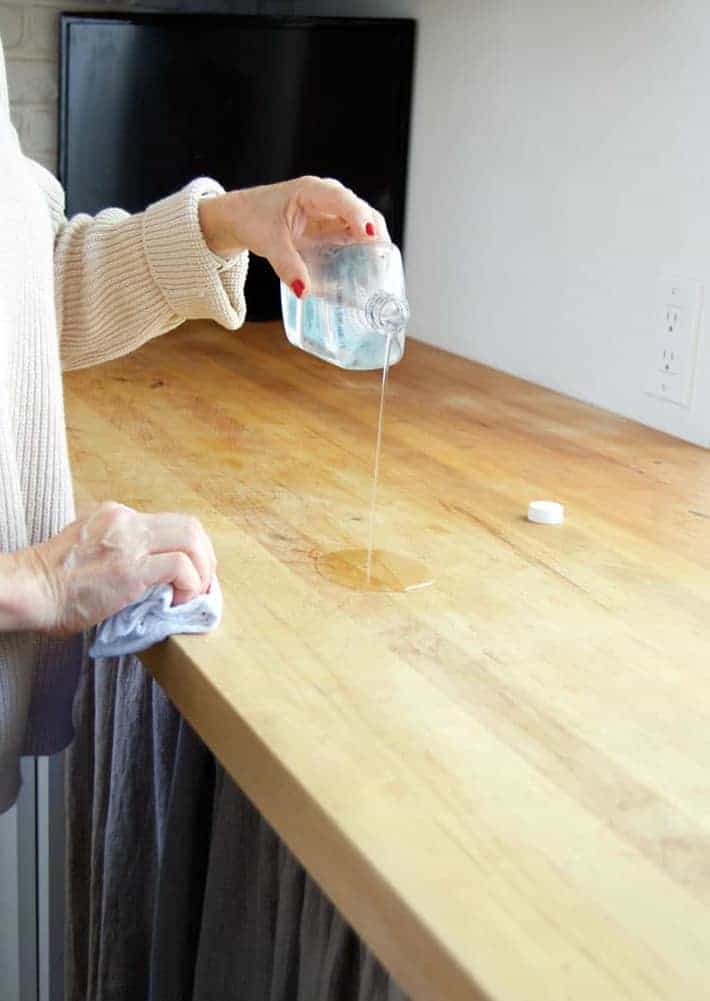
Repair and Restoration
Fixing Scratches and Dents
Despite your best efforts, scratches and dents may still occur on your butcher block countertop. Minor scratches can often be addressed with a simple touch-up. Rub the scratched area with fine-grit sandpaper until the scratch is smooth and blends with the surrounding wood. For deeper scratches or dents, use a damp cloth to steam the area, which can help raise the wood fibers. Afterward, sand the area and reapply oil or finish to restore its appearance.
Addressing Warping and Cracks
Warping and cracking can happen due to fluctuations in temperature and humidity. If you notice minor warping, try placing a damp cloth on the affected area and then use a warm iron to gently press it flat. For cracks, fill them with wood filler or a mixture of sawdust and glue, then sand the area smooth and reapply the finish. In severe cases of warping or cracking, professional repair or replacement may be necessary.
Refinishing for a Fresh Look
Over time, your butcher block countertop may lose its luster and develop a worn appearance. Refinishing can breathe new life into the wood and restore its original beauty. Start by thoroughly cleaning the countertop and removing any existing finish. Sand the surface to remove scratches and smooth out any imperfections. Once sanded, clean off the dust and apply a new coat of oil or finish, allowing it to soak in and dry completely. This process not only improves the appearance of your countertop but also adds an extra layer of protection.
Professional Restoration Services
If your butcher block countertop has significant damage or wear, consider hiring a professional restoration service. Experts can assess the condition of the wood and perform necessary repairs, such as deep sanding, filling cracks, and applying specialized finishes. Professional restoration can extend the life of your countertop and ensure it remains a functional and beautiful part of your kitchen for years to come.

Common Mistakes to Avoid
Neglecting Regular Maintenance: Skipping regular oiling and cleaning can lead to a buildup of stains, odors, and moisture damage. Consistent maintenance is crucial for preserving the beauty and longevity of your butcher block countertop.
Using Harsh Chemicals: Harsh cleaners can strip the wood of its natural oils and damage the finish. Stick to mild, natural cleaning solutions to avoid compromising the integrity of the wood.
Allowing Prolonged Moisture Exposure: Leaving wet items or spills on the countertop can cause the wood to warp, crack, or develop mold. Always wipe up spills immediately and ensure the countertop is dry.
Cutting Directly on the Countertop: While the butcher block is designed for cutting, using cutting boards can prevent deep scratches and knife marks, maintaining the smooth surface of the countertop.
Ignoring Temperature Fluctuations: Exposure to extreme heat or rapid temperature changes can cause the wood to warp or crack. Use trivets for hot items and maintain stable indoor humidity levels to protect the countertop.

How often should I oil my butcher block countertop?
Regular oiling is essential to keep your butcher block countertop in good condition. For new countertops, oiling once a week for the first month helps build up a protective layer. After that, oiling once a month or every few months, depending on usage and environmental factors, should suffice. If the wood starts to look dry or feels rough, it’s a sign that it needs oiling.
Can I use my butcher block countertop as a cutting board?
While butcher block countertops can handle cutting, it’s best to use separate cutting boards for chopping tasks. Cutting directly on the countertop can leave scratches and knife marks, which may harbor bacteria and require more frequent sanding and refinishing. Using cutting boards helps maintain the smooth surface and prolong the life of your countertop.
How do I remove stains from my butcher block countertop?
To remove stains, create a paste with baking soda and water and apply it to the stained area. Let it sit for a few minutes, then scrub gently with a soft sponge. For tougher stains, use a mixture of lemon and salt. Avoid using harsh chemicals or bleach, as they can damage the wood. Regular maintenance and immediate cleaning of spills can prevent stains from setting in.
What should I do if my butcher block countertop starts to warp or crack?
Warping and cracking can occur due to changes in humidity or temperature. For minor warping, place a damp cloth on the affected area and use a warm iron to press it flat. For cracks, fill them with wood filler or a mixture of sawdust and glue, then sand and refinish the area. In severe cases, professional repair may be necessary to restore the countertop.
Are butcher block countertops sanitary for food preparation?
When properly maintained, butcher block countertops can be sanitary for food preparation. Regular cleaning, oiling, and sealing help prevent bacterial growth and protect the wood from moisture. Using separate cutting boards for raw meat and other foods can further enhance hygiene. Ensuring the countertop is dry and free from deep cuts or scratches also contributes to a sanitary surface.
How to Clean Butcher-Block Countertops
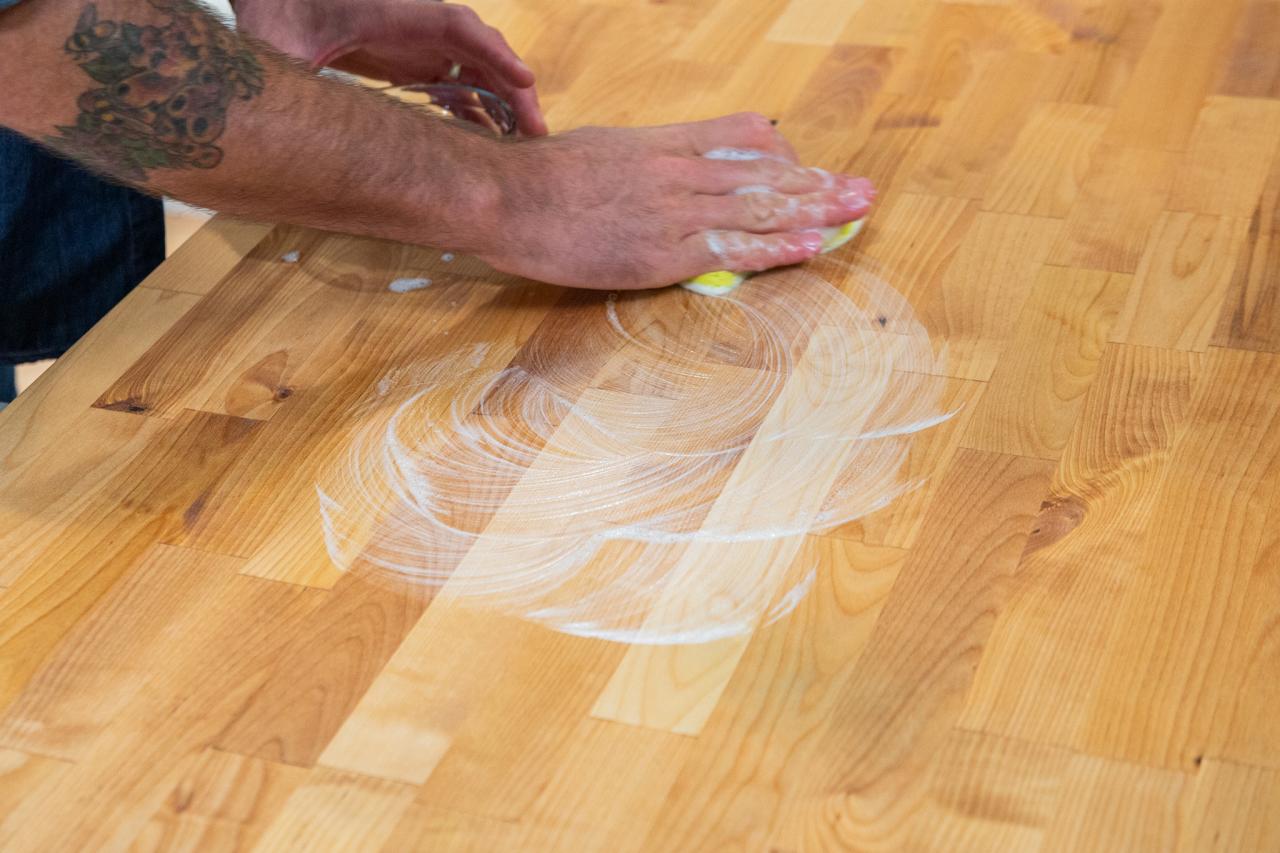
How to Care for Butcher Block Countertops
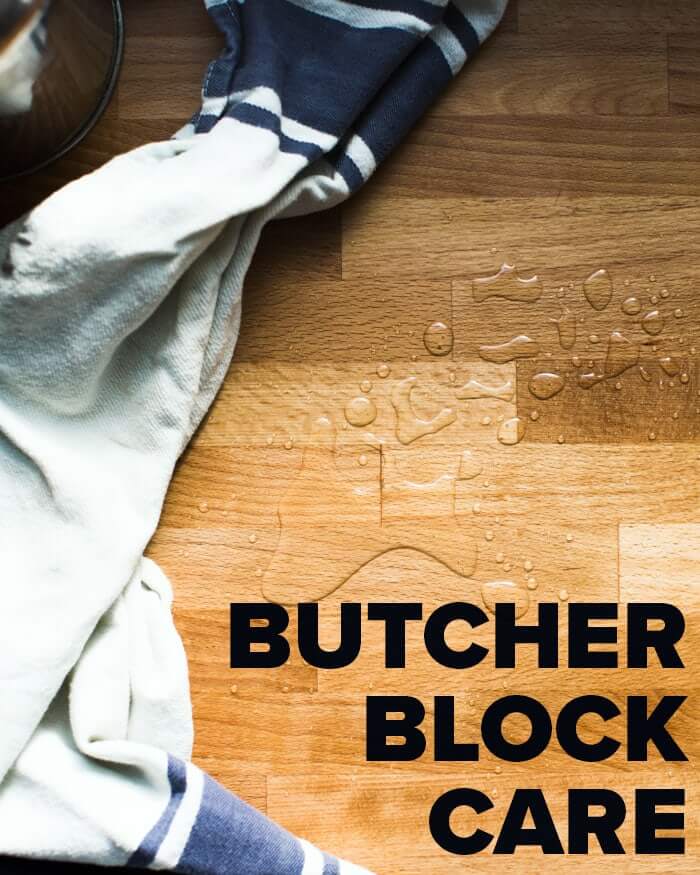
How to Care For Your Butcher Block Countertops – Cabinets by Graber
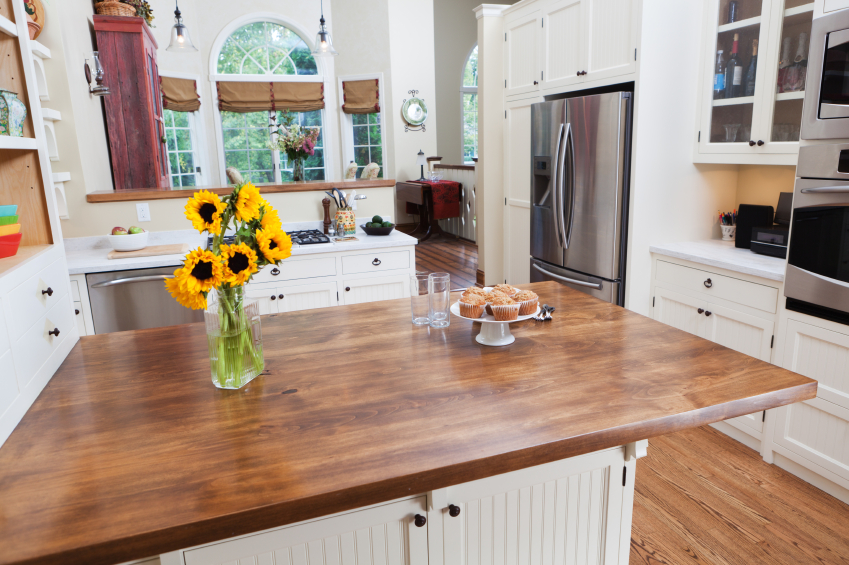
My Take on Butcher Block Countertops

Related articles:
- Thick Butcher Block Countertop
- How To Finish A Butcher Block Countertop
- Butcher Block Countertops Sealing
- Butcher Block Countertops Redo
- Dark Stained Butcher Block Countertops
- Staining Butcher Block Countertops
- Butcher Block Countertops Mineral Oil
- How To Finish Butcher Block Countertops
- Pine Butcher Block Countertops
- Used Butcher Block Countertops